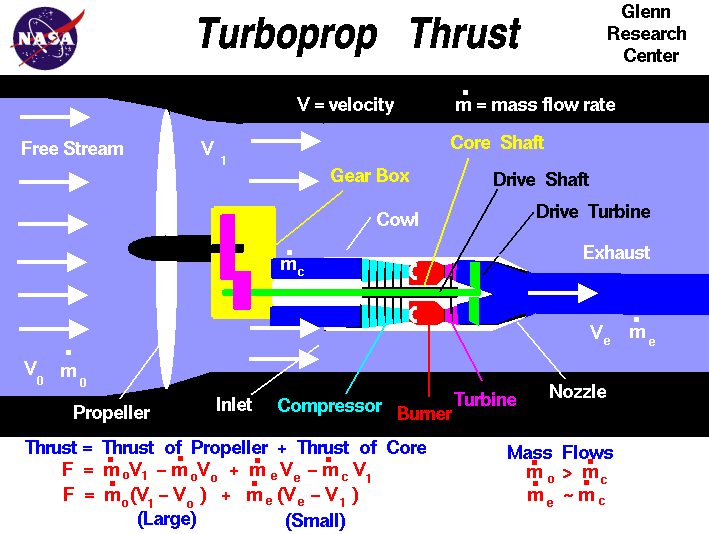
To move an airplane through the air,
thrust is generated with some kind of
propulsion system. Many low speed transport
aircraft and small commuter aircraft use
turboprop
propulsion.
On this page we will discuss some of the fundamentals of turboprop
engines. The turboprop uses a gas turbine core
to turn a propeller. Propellers
develop thrust by moving a large mass of air through a
small change in velocity. Propellers are very efficient and can use
nearly any kind of engine to turn the prop. General aviation aircraft
use an
internal combustion engine to
turn the propeller. In
the turboprop, a gas turbine core is used. How does a turboprop
engine work?
There are two main parts to a
turboprop propulsion system, the core engine and the propeller. The
core is very similar to a basic turbojet
having a
compressor,
burner, and
turbine.
However, at the exit of the main turbine the hot exhaust gas is passed
through an additional turbine, shown in green on the schematic, before
entering the
nozzle.
Unlike a basic turbojet, most of the energy of the exhaust is used
to turn this additional turbine.
The turbine is attached to an additional drive shaft which passes through
the core shaft and is connected to a gear box. The gear box is then
connected to a propeller that produces most of the thrust. The
exhaust velocity of the core is low and contributes little thrust
because most of the energy of the core exhaust has gone into turning
the drive shaft.
Turning to the math at the bottom of the slide, the thrust of a
turboprop is the sum of the thrust of the propeller plus the thrust
of the core. We can use our basic thrust
equation on the propeller and core to obtain the thrust equation
for the turboprop.
We denote the free stream conditions by the subscript "0", the conditions
at the exit of the propeller by "1", the exit of the core by "e", and
the entrance to the core by "c". The mass flow rate is given by m dot and
the velocity of the flows by V. The basic thrust equation then becomes:
F = (m dot)0 * V1 - (m dot)0 * V0 + (m dot)e * Ve - (m dot)c * V1
As we have noted above, the mass
flow rate through the propeller (m dot)0 is much greater than
the mass flow through the core engine (m dot)c. And we have
also noted that the exhaust velocity of the core Ve is low and almost
equal to the velocity into the core V1. The mass flow rate exiting the
core (m dot)e is almost equal to the mass into the core (m dot)c.
Mathematicians use
the symbol "~" for "almost equals." Collecting this information, we
can simplify our basic thrust equation:
F = (m dot)0 * (V1 -V0) + (m dot)e * (Ve - V1)
The first term of this equation is large compared to the
second term. Comparing with
the pure propeller theory, the thrust is equal to the mass flow
through the propeller times the velocity change across the propeller
plus a smaller amount of thrust from the core engine.
Because propellers become less efficient as the speed of the
aircraft increases, turboprops are used only for
low speed
aircraft, like cargo planes.
High speed
transports usually use high
bypass turbofans because of the high fuel efficiency and high
speed capability of turbofans. A variation of the turboprop engine is
the turboshaft engine. In a turboshaft engine, the gear box is
not connected to a propeller but to some other drive device.
Turboshaft engines are used in many helicopters, as well as tanks,
boats, and even race cars in the late 1960's.
Activities:
Guided Tours
-
 Turboprops:
Turboprops:

Navigation ..

- Beginner's Guide Home Page
|
